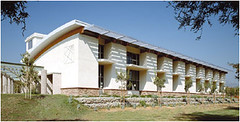If time is money, then developers just got a way to turn being green into banking some green.
The city council has unanimously approved a plan to expedite the plan-check process for buildings that conform to the “silver” standard of the Leadership in Energy and Environmental Design (LEED) guidelines. The program, initiated by Councilmember Jack Weiss and me, will allow LEED-certified buildings to move to the front of the permitting line, saving developers time and money. The LEED standards, created by the US Green Building Council, establish a set of criteria developers can implement when designing their buildings that will make the construction, maintenance, and operation of these structures more environmentally friendly and energy-efficient. Included in these guidelines are credits for using green power, employing water efficient landscaping, building near public transit, and using recycled materials during construction. Each one makes Los Angeles a cleaner place to live and mitigates the impact that urban building and urban living has on the environment around us. Read more...
There are different LEED standards – certified, silver, gold, and platinum – each corresponding to an increasingly high level of environmental efficiency. Los Angeles already require all new municipal facilities to be LEED-certified, and since 2003 forty-six LEED-certified municipal facilities have been built. Today’s action will spur the private sector to join the city as the leader for green building in the country, as we work to make sustainable living in an urban setting a viable option.
According to Global Green , construction and maintenance of buildings are responsible for 40% of energy use and 30% of the wood and raw materials used. Equally taxing on the environment are the large amounts of pollution and waste produced by buildings, which create local pollution, drain natural resources, and accelerate climate change globally. The LEED certification process gives developers and communities alike the chance to alleviate the negative consequences of urban life with well-thought out designs, sustainable products, and emerging technologies. By encouraging the private sector to go green, we can transform both our built and natural environment. LA’s leadership in so many areas of life is known all over the world, and as urban life in the new century continues to transform around us, becoming a LEED city will ensure that we remain part of the solution and not the problem.
skip to main |
skip to sidebar

|
tags
Blog Archive
- September 2011 (18)
- August 2011 (20)
- July 2011 (27)
- June 2011 (24)
- May 2011 (39)
- April 2011 (26)
- March 2011 (47)
- February 2011 (28)
- January 2011 (14)
- December 2010 (25)
- November 2010 (13)
- October 2010 (23)
- September 2010 (12)
- August 2010 (6)
- July 2010 (12)
- June 2010 (10)
- May 2010 (13)
- April 2010 (30)
- March 2010 (30)
- February 2010 (32)
- January 2010 (35)
- December 2009 (27)
- November 2009 (24)
- October 2009 (31)
- September 2009 (25)
- August 2009 (36)
- July 2009 (31)
- June 2009 (43)
- May 2009 (25)
- April 2009 (37)
- March 2009 (28)
- February 2009 (21)
- January 2009 (22)
- December 2008 (16)
- November 2008 (10)
- October 2008 (15)
- September 2008 (14)
- August 2008 (5)
- July 2008 (16)
- June 2008 (17)
- May 2008 (12)
- April 2008 (15)
- March 2008 (8)
- February 2008 (10)
- January 2008 (8)
- December 2007 (12)
- November 2007 (10)
- October 2007 (13)
- September 2007 (13)
- August 2007 (7)
- July 2007 (17)
- June 2007 (12)
- May 2007 (24)
- April 2007 (18)
- March 2007 (16)
- February 2007 (9)
- January 2007 (18)
- December 2006 (11)
- November 2006 (8)
- October 2006 (15)
- September 2006 (16)
- August 2006 (11)
- July 2006 (14)
- June 2006 (19)
- May 2006 (13)
- April 2006 (6)
- March 2006 (14)
- February 2006 (11)
- January 2006 (15)
- December 2005 (9)
- November 2005 (11)
- October 2005 (12)
- September 2005 (10)
- August 2005 (29)
- July 2005 (13)
- June 2005 (20)
- May 2005 (22)
- April 2005 (30)
- March 2005 (21)
- February 2005 (3)
